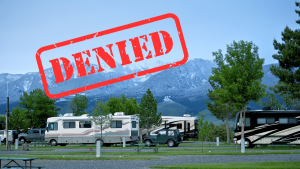Camper FAQs is reader-supported. Buying through links on our site may earn us an affiliate commission. As an Amazon Associate I earn from qualifying purchases.
Bugs are a part of outdoor life, but it doesn’t mean you have to share your RV with them. There are many practical ways to keep bugs outside where they belong.
Here’s a breakdown of the most effective ways to keep your RV as bug-free as possible.
1. Seal Up Gaps (and How to Find Them)
One of the first things to check when you’re dealing with bugs in your RV is if you’ve got any small openings where they can sneak in. Look around doors, windows, vents, plumbing, and anywhere wires or hoses come in or out. Use RV sealant for the seams and edges. If you see bigger gaps, like around pipes, expanding foam works well. For smaller holes, stuff in some steel wool before sealing it. It’s inexpensive and helps keep out bugs and even mice.
💡Tip: Not sure where the gaps are? Here’s a trick: wait until it’s dark outside, turn on all the lights inside your RV, and then walk around the outside. If you see any light leaking out around edges or vents, that’s likely a spot bugs can get through. Patch those up and you’ll cut off a lot of their entry points.
2. Watch What You Bring In
Sometimes bugs don’t find their way in; they get carried in! Firewood, lawn chairs, outdoor rugs, or even a bundle of gear you left sitting outside can all bring insects in with them.
Before bringing anything back into the RV, especially if it’s been sitting on the ground, give it a quick shake and look it over. This especially goes for firewood, which can have ants or beetles tucked inside. A quick check only takes a second and can save you from a longer cleanup later.
3. Reinforce Door and Window Screens
Standard RV screens might keep out larger bugs, but smaller pests like no-see-ums can slip right through. If you’re camping in areas with a lot of tiny flying insects, upgrading your screen mesh can make a big difference. Look for ultra-fine mesh designed specifically to block these bugs. It can usually be added over your existing screens without much hassle.
If your screens have small tears or holes, use a repair kit to patch them up. These kits often come with adhesive-backed mesh that you can trim and stick over the damaged area
4. Install Magnetic Screen Door Curtains
If your screen door doesn’t stay shut or has seen better days, a magnetic screen door curtain can help. They close on their own and make it easy to go in and out, especially if you have pets. Even if you have a screen door, magnetic screen curtains can provide an additional layer of bug protection.
5. Cover Roof and Appliance Vents with Mesh
Bugs often get in through vents. You can replace the vent covers with ones that include built-in insect mesh. Or cut fine aluminum screen material and secure it with high-heat tape or zip ties inside the vent housing.
6. Clean Up Food and Crumbs
Spilled food and sticky counters attract all kinds of insects. Wipe up messes right away using a vinegar and water mix. Avoid leaving food out, and keep trash sealed and emptied regularly.
7. Use Natural Bug Deterrents
Bay leaves in kitchen cabinets, peppermint oil sprayed around doorways, and small sachets of dried lavender, cedar, or citrus peels in drawers may help repel bugs without harsh chemicals.
8. Switch to Yellow Bug Lights
Bright white lights attract insects, especially if placed near doors. Use yellow LED bug lights outside to cut down on activity. Inside the RV, using motion-activated lights can reduce how often bugs are drawn to your rig.
9. Set Up a Bug-Free Outdoor Area
Put a screen room, mesh gazebo, or awning enclosure just outside your RV door. Add a fan to keep air moving (which many bugs hate), set up battery-powered bug zappers, and place pots of mint, citronella, or basil nearby.
10. Add RV Skirting to Block Under-Rig Bugs
Dark, damp areas under your RV can attract bugs. Use insulated or fabric skirting with mesh at the bottom. You can also sprinkle diatomaceous earth around the edges. These are safe for people but deadly for crawling insects.
11. Inspect Before You Travel
Spiders, ants, and wasps can hide in awnings, storage bays, or near the wheels. Before hitting the road, walk around your RV and check for nests, webs, or bug clusters. Spray problem areas with a safe repellent if needed.
12. Block Entry Through Hoses and Hookups
Water and sewer lines can be an access point. Use foam gaskets around connections, and store hoses in closed bins. Add fine mesh filters or screens where possible.
13. Keep Standing Water Away
Standing water around your campsite can attract mosquitoes and other insects. Make sure buckets, tarps, bins, or anything else left outside aren’t holding rainwater.
If you’re using a mat or rug, check underneath it after a storm to see if water is pooling. Dump anything collecting water and let things dry out when the sun comes back. Even a small puddle can be enough to draw in bugs, especially in warm weather.
14. Treat Tires and Jacks
Ants and other bugs can climb up from the ground using the stabilizer jacks or tire chocks. Apply petroleum jelly, bug barrier tape, or even a ring of diatomaceous earth around those areas.
15. Handle Firewood Carefully
Firewood often carries bugs. Don’t store it inside or right next to your RV. Keep it raised off the ground and in a bin or rack when not in use.
16. Store Pet Food Properly
Pet food is just as tempting to bugs as your food. Pick up bowls after feeding and keep food in airtight containers.
17. Stick to a Maintenance Schedule
Make bug checks a regular part of your RV maintenance routine. Inspect seals, patch screen holes, and reapply repellents as needed. Apps like RV Life Maintenance can help keep you on schedule.
What are your best tips to keep bugs out of your RV. Let us know below!







Write a comment